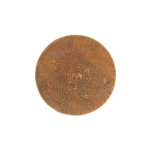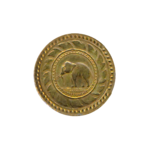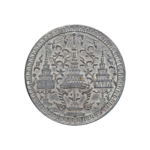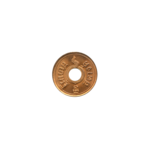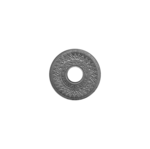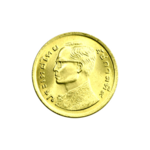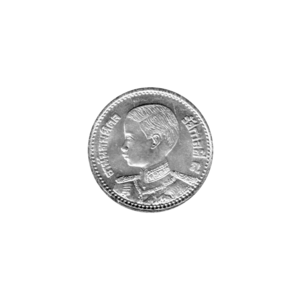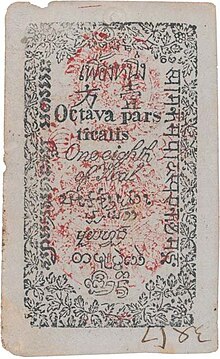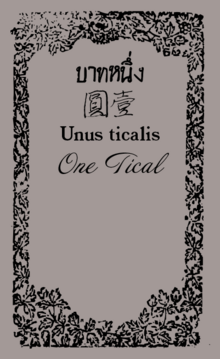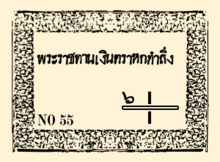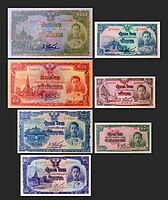Thai baht
| บาทไทย (Thai) | |
|---|---|
 Banknotes and coins of the Thai baht issued by the Bank of Thailand | |
| ISO 4217 | |
| Code | THB (numeric: 764) |
| Subunit | 0.01 |
| Unit | |
| Plural | The language(s) of this currency do(es) not have a morphological plural distinction. |
| Symbol | ฿ or บ. |
| Denominations | |
| Subunit | |
| 1⁄100 | satang |
| Banknotes | |
| Freq. used | ฿20, ฿50, ฿100, ฿500, ฿1000 |
| Coins | |
| Freq. used | 25, 50 satang, ฿1, ฿2, ฿5, ฿10 |
| Rarely used | 1, 5, 10 satang |
| Demographics | |
| Date of introduction | 1897 |
| Official user(s) | |
| Unofficial user(s) | |
| Issuance | |
| Central bank | Bank of Thailand |
| Website | www |
| Printer | Note Printing Works of the Bank of Thailand |
| Mint | Royal Thai Mint |
| Website | www |
| Valuation | |
| Inflation | 1.2% (2023) |
| Source | World Bank |
The baht (/bɑːt/; Thai: บาท, pronounced [bàːt]; sign: ฿; code: THB) is the official currency of Thailand. It is divided into 100 satang (สตางค์, pronounced [sà.tāːŋ]). Prior to decimalisation, the baht was divided into eight fueang (เฟื้อง, pronounced [fɯá̯ŋ]), each of eight at (อัฐ, pronounced [ʔat̚]). The issuance of currency is the responsibility of the Bank of Thailand. SWIFT ranked the Thai baht as the 10th-most-frequently used world payment currency as of December 2023.[1]
History
[edit]
| |||||
| Unit | |||||
|---|---|---|---|---|---|
| Plural | ticals (baht) | ||||
| Symbol | Tcs, Tcl, 圓, 銖 (no native symbols) | ||||
| Denominations | |||||
| Superunit | |||||
| 80 | chang | ||||
| 4 | tamlueng | ||||
| Subunit | |||||
| 1⁄8 | fueang | ||||
| 1⁄64 | at | ||||
| Symbol | |||||
| fueang | F, 方 | ||||
| Banknotes | |||||
| Freq. used |
| ||||
| Rarely used |
| ||||
| Coins | |||||
| Freq. used |
| ||||
| Demographics | |||||
| Date of introduction |
| ||||
| Date of withdrawal | 1910 | ||||
| User(s) | |||||
| Issuance | |||||
| Central bank | Siamese government | ||||
| Printer | see § Predecimal banknotes | ||||
| Mint | Royal Thai Mint | ||||
| Valuation | |||||
| Pegged with | Pound sterling (from 1908) (13 baht per pound) | ||||
| This infobox shows the latest status before this currency was rendered obsolete. | |||||
The Thai baht, like the pound, originated from a traditional unit of mass. Its currency value was originally expressed as that of silver of corresponding weight (now defined as 15 grams), and was in use probably as early as the Sukhothai period in the form of bullet coins known in Thai as photduang.[2] These were pieces of solid silver cast to various weights corresponding to a traditional system of units related by simple fractions and multiples, one of which is the baht. These are listed in the following table:[3][4] Though the coins themselves have names like: solot, siao, sik, etc, the formal division of the Thai baht (tical) is 1 baht = 8 fueang = 64 at. This means that one baht is divided into eight fueang, and each one fueang is divided into 8 at. Currently, the Thai baht do not employ the at as a subunit, but the at is the current subunit of the Lao kip.
| Unit (RTGS) | Thai spelling | Relative value | Value relative to | Notes | |
|---|---|---|---|---|---|
| Baht | Satang | ||||
| Bia | เบี้ย | 1⁄100 at | 1⁄6400 | 0.0156 | Bia is Thai for cowry, the shell of which was used as a trade medium of the same value. |
| Solot | โสฬส | 1⁄16 fueang | 1⁄128 | 0.78 | Solot here literally means sixteen or sixteenth, referring to the fractional amount relative to a fueang. |
| At | อัฐ | 1⁄8 fueang | 1⁄64 | 1.56 | Likewise, at means eight. |
| Siao/Phai | เสี้ยว/ไพ | 1⁄4 fueang | 1⁄32 | 3.125 | Siao means quarter. |
| Sik | ซีก | 1⁄2 fueang | 1⁄16 | 6.25 | Sik means half. |
| Fueang | เฟื้อง | 1⁄8 baht | 1⁄8 | 12.5 | The smallest silver bullet coins available in the market. |
| Salueng | สลึง | 1⁄4 baht (0.25 baht, 25 satang) | 1⁄4 | 25 | Thai version of the mace. It is also the equivalent of the Cambodian salong, and Burmese pya. |
| Baht | บาท | 1 | 100 | It is also the equivalent of the Cambodian baat, and Burmese kyat. Its alternative name is the tical. | |
| Tamlueng | ตำลึง | 4 baht | 4 | 400 | Thai version of the tael. |
| Chang | ชั่ง | 20 tamlueng | 80 | 8000 | Thai version of the catty. |
| Hap | หาบ | 80 chang | 6400 | 640000 | |

This predecimal system was in use up until 1897, when the decimal system devised by Prince Jayanta Mongkol, in which one baht = 100 satang, was introduced by his half-brother King Chulalongkorn along with the demonetization of silver bullet coins on 28 October 1904 after the end of silver bullet coin production by the opening of Sitthikarn Royal Mint in 1857.[5] However, coins denominated in the old units were issued until 1910, and the amount of 25 satang is still commonly referred to as a salueng, as is the 25-satang coin.
Until 27 November 1902, the baht was fixed on a purely silver basis, with 15 grams of silver to the baht. This caused the value of the currency to vary relative to currencies on a gold standard. From 1856 to 1864, the values of certain foreign silver coins were fixed by law, with 5 baht = 3 Spanish dollar = 7 Indian rupees.[6] Before 1880 the exchange rate was fixed at 8 baht per pound sterling, falling to 10 to the pound during the 1880s.
In 1902, the government began to increase the value of the baht by following all increases in the value of silver against gold but not reducing it when the silver price fell. Beginning at 21.75 baht per pound sterling, the currency rose in value until, in 1908, a fixed peg to the British pound sterling was established of 13 baht per pound. This was revised to 12 baht in 1919 and then, after a period of instability, to 11 baht in 1923. During World War II, the baht was fixed at a value of one Japanese yen on 22 April 1942.[7][8]
From 1956 until 1973, the baht was pegged to the US dollar at an exchange rate of 20.8 baht = one dollar and at 20 baht = 1 dollar until 1978.[9] [10] A strengthening US economy caused Thailand to re-peg its currency at 25 to the dollar from 1984 until 2 July 1997, when the country was affected by the 1997 Asian financial crisis. The baht was floated and halved in value, reaching its lowest rate of 56 to the dollar in January 1998. It rose to 30 per dollar in January 2021.
The baht was originally known to foreigners by the term tical,[11] which was used in English language text on banknotes until the series 2 1925.[12][13]
Currency symbol
[edit]The currency symbol for the baht is ฿ (a latin letter B with a vertical stroke). In 1986, this symbol was given a codepoint for computer use in the Thai Industrial Standard 620-2533 (Thailand's extension of ASCII), at position 0xDF. This national standard was subsequently subsumed into international standards as ISO/IEC 8859-11 ("ISO Latin-Thai"). In turn, the ISO 8859 series were transposed into the Unicode standard,[14] where the symbol was allocated the codepoint U+0E3F ฿ THAI CURRENCY SYMBOL BAHT.[15] The symbol is also used for the Panamanian balboa.[16]
Abbreviation
[edit]In Thai usage, the baht (บาท) is legally abbreviated as บ. according to Section 7 of the Currency Act, B.E. 2501.[17]
Bitcoin
[edit]For a time, the baht symbol was appropriated by some as a symbol for Bitcoin, a cryptocurrency. Following representations,[18] a separate code point (U+20BF ₿ BITCOIN SIGN, a latin letter B with two vertical strokes) was allocated in Unicode version 10.0.[19]
Square katakana
[edit]In Unicode 1.0, two codepoints were allocated to the baht, one as the currency symbol in the Thai range and one in the CJK Compatibility block as a square version of the Japanese word for "baht", written in katakana script.[20] The CJK codepoint, U+332C ㌬ SQUARE PAATU, is documented in subsequent versions of the standard as "a mistaken, unused representation" and users are directed to U+0E3F ฿ THAI CURRENCY SYMBOL BAHT instead.[21] Consequently, only a few computer fonts have any content for this codepoint and its use is deprecated.[20]
(The Japanese for "baht" is バーツ (bātsu). However, the reference glyph ⟨㌬⟩ and the character name correspond to パーツ (pātsu, from English "parts").[20])
Historical symbols used before decimalization
[edit]Before decimalization, the Siamese government employed Chinese, Latin, Jawi (Malay), Devanagari, Khmer and Khom, Lanna, and Burmese scripts in banknotes and coins, as seen. The reason is not clear, though it is a common understanding that it is to ease the facilicitation of trade within Siam. It could also be the case that at the time, the capital, Bangkok (Phra Nakhon) was still a multi-cultural city, so as to be more inclusive, the government added various other language onto the currency - though by the second series after the decimalization in the 1900s, the currency was all but monolingual.
圓; yuán (บาท): This character was use during the times of Rama IV to represent baht, though this was phased out by another character which is in partially and informally used today. The only occurrence of this character was in Rama IV's banknote series.
銖; 铢; zhū (บาท): This character was in use from 1868–1925 officially on banknotes to represent baht. It is still in use today unofficially to refer to the Thai baht in general, as in 泰銖 or 泰铢.
錢; 銭; qián (สลึง): This character was in use from 1851–1908 officially on banknotes and coins to represent salueng.
方; fāng (เฟื้อง): This character was in use from 1851–1908 officially on banknotes and coins to represent fueang.
The notation for these chinese character are written like they are in Thai, though there is a caveat: it is written right to left, as was the convention back then, so one baht is written 圓壹 or 銖壹, if there are smaller units involved the notation can write like such: 方銭參圓壹 for one baht, three salueng, and one fueang.
Coins
[edit]Summary
[edit]Photduang coinage
[edit]
Cowrie shells from the Mekong River had been used as currency for small amounts since the Sukhothai period. Before 1860, Thailand did not produce coins using modern methods. Instead, a so-called "bullet" coinage was used, consisting of bars of metal, thicker in the middle, bent round to form a complete circle on which identifying marks were stamped.[22][23] Denominations issued included 1⁄128, 1⁄64, 1⁄32, 1⁄16, 1⁄8, 1⁄2, 1, 1+1⁄2, 2, 2+1⁄2, 4, 4+1⁄2, 8, 10, 20, 40 and 80 baht in silver and 1⁄32, 1⁄16, 1⁄8, 1⁄2, 1, 1+1⁄2, 2 and 4 baht in gold. One gold baht was generally worth 16 silver baht. Between 1858 and 1860, foreign trade coins were also stamped by the government for use in Thailand.
Sukhothai and Ayutthaya photduang
[edit]Photduang, a form of currency used during the Sukhothai period, was characterized by its longer legs, which created a larger and wider hole in the middle. These coins were primarily made of silver and featured a cut across the front of each leg. This cut served a dual purpose: it authenticated the money and allowed for the quality of the silver to be tested. Over time, as the Sukhothai Kingdom declined and became a vassal state of Ayutthaya—which was established as the capital in 1350—the design of photduang evolved. The coins became rounder with shorter legs, and the central hole, while still present, grew smaller. By the end of this era, the hole disappeared completely. The cuts on the legs also reduced in size and were eventually replaced by a small elliptical nick, known as "Met Kao San," on one side of the coin.[24]
Thonburi and Rattanakosin photduang
[edit]The Thonburi period (1767–1782) and the Rattanakosin period, beginning in 1782, adopted the photduang design from the late Ayutthaya period. The coins from these periods had no central hole, and the legs were even shorter. A key difference was that Thonburi photduang lacked the elliptical nick, whereas the Rattanakosin coins reintroduced this feature, similar to the Ayutthaya coins. Photduang from these later periods typically featured two stamped marks: the dynasty mark on top and the king's personal mark on the front part. The dynasty mark often symbolized the kingdom's ruling dynasty, while the king's personal mark represented the reigning monarch.[24]
Markings on the photduang
[edit]The markings on photduang coins varied across different periods. During the Sukhothai era, some coins bore no marks, while others had up to 11. This variation was because, at that time, individuals and merchants could produce their own money. However, from the Ayutthaya period onward, the production of photduang was monopolized by the government, making it easier to identify coins from each era. Ayutthaya photduang typically bore two marks: the dynasty mark, which could be a spoked wheel symbolizing the "Wheel of Law" from Buddhist teachings or the Chakra (Vishnu's weapon), represented by a pattern of 8 dots surrounding a central dot. The king's personal mark varied with each ruler and included symbols such as a conch shell, a Garuda bird (khrut), an elephant, and an anchor, each symbolizing different aspects of the king's reign or divine associations.[24]
Photduang timeline
[edit]
[25] *continues in the coin section*
| Photduang of the Thai tical (Rama III & Rama IV)[26] | |||||||||
|---|---|---|---|---|---|---|---|---|---|
| Image | Names | Value | Width (mm) |
Weight (g) |
Composition | Inscription, description | Date of issue | ||
| Primary | Secondary | in silver baht |
in gold baht | ||||||

|
Bia เบี้ย |
1⁄6400 | 1⁄102400 | 25 | 1.58 | Calcium carbonate | None | 1238–1869 | |

|
Half Phai กึ่งไพ |
At อัฐ |
1/64 | 1/1024 | 2 | 0.25 | Silver | State ensign of Rattanakosin | 1824–1851 |

|
Phai ไพ |
1/32 | 1/512 | 4 | 0.5 | Silver | State ensign of Rattanakosin Castle |
1824–1856 | |

|
2 Phai สองไพ |
Half Fueang กึ่งเฟื้อง |
1/16 | 1/256 | 6 | 1 | Silver | State ensign of Rattanakosin Castle |
1824–1856 |

|
Fueang เฟื้อง |
1/8 | 1/128 | 6.5 | 1.98 | Silver | State ensign of Rattanakosin Castle |
1824–1856 | |

|
Salueng สลึง |
1/4 | 1/64 | 9 | 3.7 | Silver | State ensign of Rattanakosin Castle |
1824–1856 | |

|
2 Salueng สองสลึง |
Half Baht กึ่งบาท |
1/2 | 1/32 | 11 | 7.6 | Silver | State ensign of Rattanakosin Castle |
1824–1856 |

|
Baht บาท |
1 | 1/16 | 14.5 | 15.14 | Silver | State ensign of Rattanakosin Castle |
1824–1856 | |

|
Gold 2 Phai สองไพทอง |
Gold Half Fueang กึ่งเฟื้องทอง |
1 | 1/16 | 5 | 1 | Gold | State ensign of Rattanakosin Phra Maha Mongkut seal |
1851–1856 |
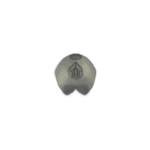
|
2 Baht สองบาท |
Half Tamlueng กึ่งตำลึง |
2 | 1/8 | 17.5 | 30.30 | Silver | State ensign of Rattanakosin Castle |
1824–1856 |

|
Gold Fueang เฟื้องทอง |
2 | 1/8 | 6 | 1.5 | Gold | State ensign of Rattanakosin Phra Maha Mongkut seal |
1851–1856 | |

|
4 Baht สี่บาท |
Tamlueng ตำลึง |
4 | 1/4 | 23.5 | 60.50 | Silver | State ensign of Rattanakosin Castle |
1824–1856 |

|
Gold Salueng สลึงทอง |
4 | 1/4 | 8 | 3.7 | Gold | State ensign of Rattanakosin Phra Maha Mongkut seal |
1851–1856 | |

|
Gold 2 Salueng สองสลึงทอง |
Gold Half Baht กึ่งบาททอง |
8 | 1/2 | 9.5 | 7.56 | Gold | State ensign of Rattanakosin Phra Maha Mongkut seal |
1851–1856 |

|
Gold Baht บาททอง |
16 | 1 | 12 | 15.14 | Gold | State ensign of Rattanakosin Phra Maha Mongkut seal |
1851–1856 | |

|
Gold 2 Baht สองบาททอง |
Gold Half Tamlueng กึ่งตำลึงทอง |
32 | 2 | 16 | 30.01 | Gold | State ensign of Rattanakosin Phra Maha Mongkut seal |
1851–1856 |

|
40 Baht สี่สิบบาท |
Half Chang กึ่งชั่ง |
40 | 2.5 | 48 | 606.5 | Silver | State ensign of Rattanakosin Phra Maha Mongkut seal |
1860 |

|
80 Baht แปดสิบบาท |
Chang ชั่ง |
80 | 5 | 59 | 1216 | Silver | State ensign of Rattanakosin Phra Maha Mongkut seal |
1859 |
Predecimal coinage
[edit]Rama III (1824–1851) was the first king to consider the use of a flat coin. He did so not for the convenience of traders, but because he was disturbed that the creatures living in the cowrie shells were killed. When he learned of the use of flat copper coins in Singapore in 1835, he contacted a Scottish trader, who had two types of experimental coins struck in England. The king rejected both designs. The name of the country put on these first coins was Muang Thai, not Siam.[27][28]
In 1860, modern-style coins were introduced. These were silver 1 sik; 1 fueang; 1 and 2 salueng; 1, 2, and 4 baht; with the baht weighing 15.244 grams and the others weight-related. Tin 1 solot and 1 at followed in 1862, with gold 2+1⁄2, 4, and 8 baht introduced in 1863 and copper 2 and 4 at in 1865. Copper replaced tin in the 1 solot and 1 at in 1874, with copper 4 at introduced in 1876. The last gold coins were struck in 1895.
Coin timeline
[edit]
Issue 1 - 1856 (transitional)
[edit]The first issue of coins were commissioned by Rama IV, though it was never brought into circulation. This was one of the first attempt to replace the bullet coins, but few were ever minted without making it into circulation.[29]
Issue 2 - 1860
[edit]The first circulating issue of the Siamese coins. This marked the start of the move away from using photduang currency. Though in this era, the photduang were still legal tender. In this series, the lower denominations were made of silver, and the higher ones were made of gold. These higher denominations were given nicknames: pot dueng, pit, and tot. Pot dueng means thirty two, as in 1/32 of a chang. The other nickname was the chinkang or one Chinese tamlueng.[30] The pit means twenty, as in 1/20 of a chang, the other name is ekkang, or one thai tamlueng.[31] The tot means ten, as in 1/10 of a chang. The coin was also called thukkang, which means two tamlueng.[32] In the lower denominations materials such as tin, copper and brass are used, since these are quite low value.
According to the Thai Treasury, regarding the gold coins, they were minted during a period when large amounts of gold were entering Thailand. Inspired by the widespread use of gold coins in other countries, such as the gold coins of England, King Mongkut (Rama IV) ordered the production of gold coins for domestic use. These coins, with their higher value, facilitated trade as the silver coins in circulation at the time were of lower value. They were officially issued on October 29, 1863, and were withdrawn from use in 1908.[33]
This series of coins was produced using manually operated machinery that had been presented as a royal gift by Queen Victoria of England. Due to the limited production capacity of these machines, the coins could not be minted in sufficient quantities to meet the country's demand. Consequently, their use was discontinued. This coincided with the arrival of steam-powered machinery, which allowed for more efficient and larger-scale coin production.[34] It is worth noting that coins of the half-fuang denomination were not mentioned in official announcements.[35]
In 1866, These thin copper coins, in sik (half-fuang) and siao (quarter-fuang) denominations, were produced to replace their thicker counterparts, which were heavier and had the same value. The decision to issue lighter, thinner coins was made after an incident where King Mongkut (Rama IV) distributed the thicker coins during a charitable event, and recipients were injured with head wounds and bruises. His Majesty considered that the copper coins already bore stamped marks and inscriptions (indicating that 2 coins equaled 1 fuang and 4 coins equaled 1 fuang), making them trustworthy. Therefore, thinner and lighter coins would still serve their purpose effectively without causing harm.[36]
Issue 3 - 1875
[edit]The first series to depict king Rama V, the coins of this issue were made of copper, silver, and gold. Though gold was strangely only used for the 1 fueang denomination.[37] The new shield emblem was introduced in this issue. This shield was separated into three section. Drawing from western influences, symbols within these sections represented territories Siam was controlling. The tree-headed elephant represented Siamese territory, the bottom-left elephant represented Lan Xang, and the warangka represented Siamese Malaya.
Due to a malfunction in the minting machinery at the government mint, which prevented the production of circulating coinage, King Chulalongkorn ordered the design of this coin series and commissioned its production by a mint in Birmingham, England. This marked the first time that coins were minted abroad for circulation in Siam.[38] The copper coins in this issue were made in the same size as the coins of the United Kingdom, with the Solot being the same size as the Farthing, the Att being the same size as the Half-Penny, and the Siao being the same size as the Penny. The silver coins differ in size to the British counterpart due to the baht being pegged to a different unit of silver. The copper coin in this case were base metal and were not pegged to any standard metal, hence their size tend to differ more throughout history. These copper coins only represent a certain amount of silver.
These silver coins were minted when the Sathit Kuang machinery was put into use in 1889 at the Sathit Kuang Coin Mint, marking the beginning of a new coinage system. The year markings started to appear on the coins from R.S. 120 (1898) onwards.[39]
| Issue 3 coins (Rama V) | |||||||||
|---|---|---|---|---|---|---|---|---|---|
| Image | Value | Dimensions (mm) |
Weight (g) |
Composition | Inscription, description | Date of issue | |||
| Obverse | Reverse | Name | Coinage value | Obverse | Reverse | ||||

|

|
Solot โสฬส |
1/16 fueang, 1/128 baht |
20 × 1 | 2.67 | Copper | กรุงสยาม (Kingdom of Siam) Monogram of Rama V รัชกาลที่ ๕ (5th Reign) |
โสลด (Solot) ๑๖ (16) อันเฟื้อง (parts fuang) ๑๒๓๖ (CS 1236) |
1875 |

|

|
At อัฐ |
1/8 fueang, 1/64 baht |
25 × 1 | 5.58 | Copper | กรุงสยาม (Kingdom of Siam) Monogram of Rama V รัชกาลที่ ๕ (5th Reign) |
อัฐ (At) ๘ (8) อันเฟื้อง (parts fuang) ๑๒๓๖ (CS 1236) |
1875 |

|

|
Siao เสี้ยว |
1/4 fueang, 1/32 baht |
30.5 × 2 | 11.14 | Copper | กรุงสยาม (Kingdom of Siam) Monogram of Rama V รัชกาลที่ ๕ (5th Reign) |
เสี้ยว (Siao) ๔ (4) อันเฟื้อง (parts fuang) ๑๒๓๖ (CS 1236) |
1875 |

|

|
Sik ซีก |
1/2 fueang, 1/16 baht |
38.5 × 2.5 | 22.57 | Copper | กรุงสยาม (Kingdom of Siam) Monogram of Rama V รัชกาลที่ ๕ (5th Reign) |
สิ้ก (Sik) ๒ (2) อันเฟื้อง (parts fuang) ๑๒๓๘ (CS 1238) |
1875 |

|

|
Fueang เฟื้อง |
1 fueang, 1/8 baht |
16 × 5.0
16 × 0.9 |
1.87 1.95 |
Silver Gold |
สมเด็จพระปรมินทรมหาจุฬาลงกรณ์ (His Majesty King Chulalongkorn) พระจุลจอมเกล้าเจ้าอยู่หัว (King Chulalongkorn) |
กรุงสยาม (Siam) รัชกาลที่๕ (5th Reign) เฟื้องหนึ่ง (1 fueang) |
1875 |

|

|
Salueng สลึง |
1/16 tamlueng, 1/4 baht |
20.5 × 1.0 | 3.75 | Silver | สมเด็จพระปรมินทรมหาจุฬาลงกรณ์ (His Majesty King Chulalongkorn) พระจุลจอมเกล้าเจ้าอยู่หัว (King Chulalongkorn) |
กรุงสยาม (Siam) รัชกาลที่๕ (5th Reign) สลึงหนึ่ง (1 salueng) |
1875 |

|

|
Baht บาท |
1/4 tamlueng, 1 baht |
31 × 2.0 | 15.1 | Silver | สมเด็จพระปรมินทรมหาจุฬาลงกรณ์ (His Majesty King Chulalongkorn) พระจุลจอมเกล้าเจ้าอยู่หัว (King Chulalongkorn) |
กรุงสยาม (Siam) รัชกาลที่๕ (5th Reign) บาทหนึ่ง (1 baht) |
1875 |
Issue 4 - 1888
[edit]This was a minor-issue, where the lesser denominations' designs were updated to incorporate the three-parted shield into the design. This copper coin was produced to replace previous versions and was minted in England, with additional production by the Royal Mint of Thailand.[40] In this issue, depending on where the coin was minted, the minting alignment was different. This means that in this specific series, the alignment will tell which mint the coin is minted at.[41] For example, during this series there were 4 mints which contributed in minting this issue: Royal Mint of Belgium, Bangkok Mint, Heaton and Sons (Burmingham Mint), and Hamburgische Mint. For the 1 Solot coin, the coin minted in the year R.S. 109 were medal aligned and was minted in the Birmingham Mint, and R.S. 118 coins were minted in Hamburg had coin alignement.[42]

Decimal coinage
[edit]The decimalization of the Thai baht came about at the end of the 19th century. The minister of treasury, Jayanta Mongkol, the Prince Mahisara Rajaharudaya, suggested to King Rama V, that decimalization would make counting easier and further modernize Siam. Initially, there would be one superunit, chang, and one subunit, at. with the baht being in the middle. In summary, 64 at = 1 baht = 1/80 chang. In reality, this was just a simplification of the old system, which was scrapped.[43] In which, during the period of 1902–1908, Siam went back to the old system. Though in comparison, at is used as the subunit in Laos, compared to the satang in the Thai baht. The second attempt came at the end of Rama V's reign, where it was more widely accepted and put into effective use.
In 1897, the first coins denominated in satang were introduced, cupronickel 2+1⁄2, 5, 10, and 20 satang. However, 1 solot, 1, and 2 at coins were struck until 1905 and 1 fueang coins were struck until 1910. In 1908, holed 1, 5, and 10 satang coins were introduced, with the 1 satang in bronze and the 5 and 10 satang in nickel. The 1 and 2 salueng were replaced by 25 and 50 satang coins in 1915. In 1937, holed, bronze 1⁄2 satang were issued.
In 1941, a series of silver coins was introduced in denominations of 5, 10, and 20 satang, due to a shortage of nickel caused by World War II. The next year, tin coins were introduced for 1, 5, and 10 satang, followed by 20 satang in 1945 and 25 and 50 satang in 1946. In 1950, aluminium bronze 5, 10, 25, and 50 satang were introduced whilst, in 1957, bronze 5 and 10 satang were issued, along with 1-baht coins struck in an unusual alloy of copper, nickel, silver and zinc. Several Thai coins were issued for many years without changing the date. These include the tin 1942 1 satang and the 1950 5 and 10 satang, struck until 1973, the tin 1946 25 satang struck until 1964, the tin 50 satang struck until 1957, and the aluminium bronze 1957 5, 10, 25, and 50 satang struck until the 1970s. Cupronickel 1-baht coins were introduced in 1962 and struck without date change until 1982.
In 1972, cupronickel 5-baht coins were introduced, switching to cupronickel-clad copper in 1977. Between 1986 and 1988, a new coinage was introduced, consisting of aluminium 1, 5 and 10 satang, aluminium bronze 25 and 50 satang, cupronickel 1 baht, cupronickel-clad copper 5 baht and bimetallic 10 baht. Cupronickel-clad steel 2 baht were introduced in 2005.
Issue 5 - 1897 (transitional)
[edit]Issue 6 - 1908, 1913, 1929, 1939
[edit]These coins were all produced abroad, and they feature changes in year formatting and design differences over time. The coins were initially produced with the R.S. year system but transitioned to using the B.E. system from 1913 onwards.[44] The 1 Baht coins were replaced with banknotes starting in 1918 due to the high cost of silver. The 2 Salung and 1 Salung coins experienced changes in metal composition due to fluctuating silver prices during World War I, and these coins have slight design variations based on these changes.
During issue, there were also various debasements of the silver content of these coins. Initially, the composition was 80% silver and 20% copper. In 1918, during World War I, silver prices surged, leading to a change in the composition to 65% silver and 35% copper. In 1919, the silver percentage dropped further to 50% silver and 50% copper. After the war, in 1919, the composition returned to 65% silver and 35% copper.[45]
Near the end of this issue of coins, the transition into decimal currency was completed. The Rama VII coin was produced in two denominations, 50 Satang and 25 Satang, and marked the transition from the old currency system of "สองสลึง" (two salung) and "หนึ่งสลึง" (one salung) to the new system using Satang as a unit of currency.[46] Though, people today still refer to these denomination using the old terminology.
Issue 7 - 1937, 1941, 1942, 1945
[edit]This series of coins is distinctive as it lacks the royal insignia or the state seal, which were commonly featured in earlier designs. This series also contain a 20 satang denomination, meaning that there was a time where 25-satang and the 20-satang circulated at the same time.[47] The half-satang was introduced in 1937 to address the issue of low-value currency units in Thailand. The value of 1 Satang was considered too high for certain low-priced items, causing economic hardship for the poor. Previously, 1 Baht could be exchanged for 128 Solot, but after the switch to Satang, 1 Baht was only equivalent to 100 Satang. The introduction of this coin aimed to make it easier for ordinary people to purchase items without the burden of inflated prices. The coin was produced only once and was discontinued soon after. It was minted in Japan and first issued on July 12, 1937.[48]
In 1942, a bunch of denomination switched material due to the costs of World War 2, the 1-satang coin lost its hole in the middle and was downsized.[49]
Issue 8 - 1946
[edit]This was the first series minted in the reign of King Ananda Mahidol (Rama VIII), and it marked the return of national symbols, such as the Garuda emblem, which had been used as the national seal since the Ayutthaya period. This emblem, created during the reign of King Chulalongkorn (Rama V), became the national seal to be used permanently, avoiding the need for a new one with each reign. There are two versions of this series minted in the same year, the young portrait and the teen portrait.[50]
Issue 9 - 1950
[edit]Issue 10 - 1972
[edit]Issue 11 - 1977
[edit]Issue 12 - 1982
[edit]Issue 13 - 1987, 1988, 2005, 2008
[edit]Current coinage
[edit]The current coin series is the 14th issue.
In 2008, in the 13th issue, the Ministry of Finance and the Royal Thai Mint announced the 2009 coin series, which included changes in materials to reduce production costs as well as an update of the image on the obverse to a more recent portrait of the king. The two-baht coin, confusingly similar in color and size to the one-baht coin, was changed from nickel-clad low-carbon steel to aluminium bronze. New two-baht coin was the first of the new series released on 3 February 2009, followed by the satang coins in April, a five-baht coin in May, a ten-baht coin in June, and a one-baht coin in July 2009.
In 2018, the Royal Thai Mint and the Ministry of Finance issued a new series of general circulation coins, featuring the same standard specifications, but feature a portrait of its current king, Vajiralongkorn.
Issue 13 - 2009
[edit]| Issue 13 coins (Rama IX) [3] [4] (in Thai) | ||||||||
|---|---|---|---|---|---|---|---|---|
| Value | Technical parameters | Description | Date of first minting | |||||
| Diameter | Mass | Composition | Obverse | Reverse | ||||
| 1 satang1 | 15 mm | 0.5 g | 97.5% Al, 2.5% Mg | King Bhumibol Adulyadej | Wat Phra That Hariphunchai, Lamphun | 1987 | ||
| 99% Aluminium | 2008 | |||||||
| 5 satang1 | 16 mm | 0.6 g | 97.5% Al, 2.5% Mg | King Bhumibol Adulyadej | Wat Phra Pathom Chedi, Nakhon Pathom | 1987 | ||
| 16.5 mm | 99% Aluminium | 2008 | ||||||
| 10 satang1 | 17.5 mm | 0.8 g | 97.5% Al, 2.5% Mg | King Bhumibol Adulyadej | Wat Phra That Choeng Chum, Sakon Nakhon | 1987 | ||
| 99% Aluminium | 2008 | |||||||
| 25 satang | 16 mm | 1.9 g | Aluminium bronze | King Bhumibol Adulyadej | Wat Phra Mahathat, Nakhon Si Thammarat | 1987 | ||
| 16 mm | 1.9 g | Copperplated steel | King Bhumibol Adulyadej | Wat Phra Mahathat, Nakhon Si Thammarat | 2008 | |||
| 50 satang | 18 mm | 2.4 g | Aluminium bronze | King Bhumibol Adulyadej | Wat Phra That Doi Suthep, Chiang Mai | 1987 | ||
| 18 mm | 2.4 g | Copperplated steel | King Bhumibol Adulyadej | Wat Phra That Doi Suthep, Chiang Mai | 2008 | |||
| 1 baht | 20 mm | 3.4 g | Cupronickel (1987–2008) | King Bhumibol Adulyadej | Wat Phra Kaew, Bangkok | 1987 | ||
| 3 g | Nickelplated steel (2008–present) | 2008 | ||||||
| 2 baht | 21.75 mm | 4.4 g | Nickelplated low-carbon steel | King Bhumibol Adulyadej | Wat Saket, Bangkok | 2005 | ||
| 21.75 mm | 4 g | Aluminium bronze | King Bhumibol Adulyadej | Wat Saket, Bangkok | 2008 | |||
| 5 baht | 24 mm | 7.5 g | Cupronickel-clad copper | King Bhumibol Adulyadej | Wat Benchamabophit, Bangkok | 1988 | ||
| 6 g | 2008 | |||||||
| 10 baht | 26 mm | 8.5 g | Center plug: Aluminium bronze Outer ring: Cupronickel |
King Bhumibol Adulyadej | Wat Arun, Bangkok | 1988 | ||
| 2008 | ||||||||
Issue 14 - 2018
[edit]| Issue 14 coins (Rama X) | ||||||
|---|---|---|---|---|---|---|
| Image | Value | Composition | Description | Date of first minting | ||
| Obverse | Reverse | Obverse | Reverse | |||
| 1 satang | Aluminum | King Vajiralongkorn | Monogram of Vajiralongkorn | 2018 | ||
| 5 satang | Aluminum | King Vajiralongkorn | Monogram of Vajiralongkorn | 2018 | ||
| 10 satang | Aluminum | King Vajiralongkorn | Monogram of Vajiralongkorn | 2018 | ||
| 25 satang | Copperplated steel | King Vajiralongkorn | Monogram of Vajiralongkorn | 2018 | ||
| 50 satang | Copperplated steel | King Vajiralongkorn | Monogram of Vajiralongkorn | 2018 | ||

|

|
1 baht | Nickelplated steel | King Vajiralongkorn | Monogram of Vajiralongkorn | 2018 |

|

|
2 baht | Aluminum bronze | King Vajiralongkorn | Monogram of Vajiralongkorn | 2018 |

|

|
5 baht | Cupronickel-clad copper | King Vajiralongkorn | Monogram of Vajiralongkorn | 2018 |

|

|
10 baht | Center plug: Aluminium bronze Outer ring: Cupronickel |
King Vajiralongkorn | Monogram of Vajiralongkorn | 2018 |
Remarks
[edit]- The 1, 5 and 10 satang are used only internally between banks and are not in circulation.[51]
- Older coins, some of which are still in circulation, had only Thai numerals, but newer designs also have Arabic numerals.
- The standard-issue 10-baht coin has, at the 12 o'clock position on the reverse, raised dots corresponding to Braille cell dot 1 and dots 2-4-5, which correspond to the number 10.
- 10-baht coins are very similar to 2-euro coins in size, shape and weight, and are likewise bi-metallic, although they are worth only 25 eurocents. Vending machines not equipped with up-to-date coin detectors might therefore accept them as €2 coins or old Italian 500 lira coins as well.[52]
- Many commemorative 1-, 2-, 5- and 10-baht coins have been made for special events. There also are 20-, 50-, 100-baht base metal commemorative coins and higher-denomination precious metal coins as well.[which?]
In February 2010 the Treasury Department of Thailand stated that it has been planning a new circulation 20-baht coin.[53]
Monarch's profile
[edit]-
Rama X
-
Rama IX
-
Rama VIII
-
Rama VII
-
Rama VI
-
Rama V
Banknotes
[edit]In 1851, the government issued notes for 1⁄8, 1⁄4, 3⁄8, 1⁄2 and 1 tical, followed by 3, 4, 6 and 10 tamlueng in 1853. After 1857, notes for 20 and 40 ticals were issued, also bearing their values in Straits dollars and Indian rupees. Undated notes were also issued before 1868 for 5, 7, 8, 12 and 15 tamlueng, and 1 chang. One at notes were issued in 1874.
In 1892, the treasury issued notes for 1, 5, 10, 40, 80, 100, 400 and 800 ticals, called "baht" in the Thai text.
On 10 September 1902, the government introduced notes which were printed by Thomas De La Rue & Company Limited, England, during the reigns of Kings Rama V and Rama VI, denominated 5, 10, 20, 100 and 1000 ticals, still called baht in the Thai text — each denomination having many types,[54] with 1 and 50 tical notes following in 1918. In 1925, notes were issued in denominations of 1, 5, 10, 20, 100 and 1,000 baht with the denomination in both Arabic and Thai numerals without English text;[55] English speakers continued to refer to these as "ticals".[56]
On 27 July 2010, the Bank of Thailand announced that the 16th-series banknotes would enter circulation in December 2010.[57][58] On 9 August 2012, the Bank of Thailand issued a new denomination banknote, 80 baht, to commemorate queen Sirikit's 80th birthday.[59] It was the first Thai banknote that featured Crane's MOTION security thread.
In 2017, the Bank of Thailand announced a new family of banknotes in remembrance of the late King Bhumibol Adulyadej (Rama IX). The notes are the same size and dimensions as the "Series 16" banknotes, with the front designs as before, but the back designs featuring images of the king's life in infancy, adolescence and maturity. The new family of banknotes were issued on September 20.[60]
In 2018, the Bank of Thailand announced a new family of banknotes featuring a portrait of the current King Vajiralongkorn (Rama X). The main colors and dimensions of the notes are the same as before, with the back designs featuring images of the Kings of Thailand from past to present. The 20, 50 and 100 baht banknotes were issued on Chakri Memorial Day, April 6, 2018. The final two denominations, 500 and 1,000 baht were issued on the anniversary of the birth of King Maha Vajiralongkorn, July 28, 2018.[61]
Timeline
[edit]
Predecimal banknotes
[edit]The characteristic of the banknotes of this era was that there were no series issued at the same time, rather they were issued sporadically and had multiple banks producing their own banknotes.
1851–1868, Rama IV era banknotes
[edit]1868–1902, Rama V era banknotes
[edit]Royal Treasury banknotes
[edit]| Image | Value | Date of issue |
|---|---|---|
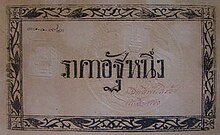
|
1 at | 1874 |

|
1 tical | 1892 |
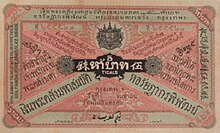
|
5 tical | |

|
10 tical | |

|
40 tical | |

|
80 tical | |

|
100 tical | |

|
400 tical | |

|
800 tical |
Hong Kong and Shanghai Banking Corporation (HSBC) banknotes
[edit]| Image | Value | Date of issue |
|---|---|---|

|
1 tical | 1889 |

|
5 tical | |

|
10 tical | |

|
40 tical | |

|
80 tical | |

|
100 tical | |

|
400 tical |
Chartered Bank of India, Australia, and China banknotes
[edit]| Image | Value | Date of issue |
|---|---|---|

|
5 tical | 1984 |

|
10 tical | |

|
40 tical | |

|
80 tical | |

|
100 tical | |

|
400 tical |
Banque de L'Indo-Chine banknotes
[edit]| Image | Value | Date of issue |
|---|---|---|

|
5 tical | 1986 |

|
20 tical | |
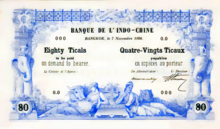
|
80 tical | |

|
100 tical |
Decimal banknotes
[edit]1902–1925 (Series 1), Rama V and Rama VI era
[edit]-
Series 1
Series 1
[edit]Series 1 was chosen due to the series which precedes this were non-decimal. Series 1 banknotes was the first series to be produced by Thomas De La Rue & Company Limited. In 1900, Charles James Rivett Carnac, a Royal Treasury Ministry advisor proposed that the Siamese baht followed the issuances of banknotes followed the British standard. The banknote department was established quickly thereafter. The main characteristic of this series was that the notes were one-sided and multilingual, containing Chinese, Malay (in Jawi script), and Latin scripts.[62] It was also the last series to use the term "tical" to refer to the Thai baht and the largest in term of size of the circulated notes.
| Series 1 banknotes (Rama V, VI) issued for 26 years | |||||||
|---|---|---|---|---|---|---|---|
| Value | Dimensions | Main colour | Description | Date of issue | |||
| Obverse | Reverse | ||||||
| 1 tical | 165 × 105 mm | Cyan | none | blank | 1918–1925 | ||
| 5 ticals | 165 × 105 mm | Grey | none | blank | 1902–1925 | ||
| 10 ticals | 205 × 126 mm | Brown | none | blank | 1902–1925 | ||
| 20 ticals | 205 × 126 mm | Green | none | blank | 1902–1925 | ||
| 50 ticals | 165 × 105 mm | Grey | none | blank | 1918–1925 | ||
| 100 ticals | 205 × 126 mm | Grey | none | blank | 1903–1928 | ||
| 1000 ticals | 205 × 126 mm | Red | none | blank | 1902–1928 | ||
1925–1935 (Series 2 to Series 3 Type 1), Rama VII era
[edit]-
Series 2
-
Series 3 Type 1
Series 2
[edit]Series 2 banknotes were produced by Thomas De La Rue & Company Limited.
| Series 2 banknotes (Rama VII) issued for 9 years | |||||||
|---|---|---|---|---|---|---|---|
| Value | Dimensions | Main colour | Description | Date of issue | |||
| Obverse | Reverse | ||||||
| 1 baht | 135 × 75 mm | Blue and yellow | none | Royal Ploughing Ceremony | 1925–1934 | ||
| 5 baht | 155 × 85 mm | Green and grey | none | Royal Ploughing Ceremony | 1925–1934 | ||
| 10 baht | 175 × 95 mm | Red | none | Royal Ploughing Ceremony | 1925-1934 | ||
| 20 baht | 175 × 95 mm | Green | none | Royal Ploughing Ceremony | 1925–1934 | ||
| 100 baht | 175 × 95 mm | Blue and green | none | Royal Ploughing Ceremony | 1928–1934 | ||
| 1000 baht | 195 × 105 mm | Red | none | Royal Ploughing Ceremony | 1928–1934 | ||
Series 3 Type 1
[edit]Series 3 type 1 banknotes were produced by Thomas De La Rue & Company Limited. This series was actually delayed due to the Siamese revolution to abolish the absolute monarchy and transform it into a constitutional monarchy. The issuance was supposed to happen in the early 1930s.
| Series 3 Type 1 banknotes (Rama VII) issued for 1 years | |||||||
|---|---|---|---|---|---|---|---|
| Value | Dimensions | Main colour | Description | Date of issue | |||
| Obverse | Reverse | ||||||
| 1 baht | 135 × 75 mm | Green | King Prajadhipok and Suphannahongse Royal Barge | Phra Samut Chedi Temple | 1934–1935 | ||
| 5 baht | 155 × 85 mm | Green and grey | King Prajadhipok and Temple of the Emerald Buddha | Phra Samut Chedi Temple | 1934–1935 | ||
| 10 baht | 175 × 95 mm | Brown | King Prajadhipok and a scene of the Mae Ping River | Phra Samut Chedi Temple | 1934–1935 | ||
| 20 baht | 175 × 95 mm | Green | King Prajadhipok and a scene of a riverside community | Phra Samut Chedi Temple | 1934–1935 | ||
1935–1948 (Series 3 Type 2 to Series 8), Rama VIII era
[edit]-
Series 3 Type 2
-
Series 4 Type 1
-
Series 4 Type 2
-
Series 5
-
Series 6
-
Series 7
-
Series 8
Series 3 Type 2
[edit]Series 3 type 2 banknotes were produced by Thomas De La Rue & Company Limited. It was the first series to hold King Rama VIII's portrait, which replaced King Rama VII's portrait in the type 1.
| Series 3 Type 2 banknotes (Rama VIII) issued for 2 years | |||||||
|---|---|---|---|---|---|---|---|
| Value | Dimensions | Main colour | Description | Date of issue | |||
| Obverse | Reverse | ||||||
| 1 baht | 135 × 75 mm | Green | Young King Ananda Mahidol and Suphannahongse Royal Barge | Phra Samut Chedi Temple | 1935–1937 | ||
| 5 baht | 155 × 85 mm | Green and grey | Young King Ananda Mahidol and Temple of the Emerald Buddha | Phra Samut Chedi Temple | 1935–1937 | ||
| 10 baht | 175 × 95 mm | Brown | Young King Ananda Mahidol and a scene of the Mae Ping River | Phra Samut Chedi Temple | 1935–1937 | ||
| 20 baht | 175 × 95 mm | Green | Young King Ananda Mahidol and a scene of a riverside community | Phra Samut Chedi Temple | 1935–1937 | ||
Series 4 Type 1
[edit]Series 4 type 1 banknotes were produced by Thomas De La Rue & Company Limited.
| Series 4 Type 1 banknotes (Rama VIII) issued for 5 years | |||||||
|---|---|---|---|---|---|---|---|
| Value | Dimensions | Main colour | Description | Date of issue | |||
| Obverse | Reverse | ||||||
| 1 baht | 125 × 65 mm | Green | Young King Ananda Mahidol and Phra Samut Chedi | Ananta Samakhom Throne Hall | 1937–1942 | ||
| 5 baht | 135 × 76 mm | Green and grey | Young King Ananda Mahidol and Phra Pathom Chedi | Ananta Samakhom Throne Hall | 1937–1942 | ||
| 10 baht | 145 × 87 mm | Brown | Young King Ananda Mahidol and Mahakarn Fortress | Ananta Samakhom Throne Hall | 1937–1942 | ||
| 20 baht | 145 × 87 mm | Green | Young King Ananda Mahidol and Golden Mountain Stupa | Ananta Samakhom Throne Hall | 1937–1942 | ||
| 1000 baht | 195 × 100 mm | Red | Young King Ananda Mahidol and a Dusidabhirom Pavilion | Ananta Samakhom Throne Hall | 1937–1942 | ||
Series 4 Type 2
[edit]Series 4 type 2 banknotes were produced by Royal Thai Survey Department and the Naval Hydrographic Department. During World War II, Thailand was allied with the Empire of Japan. This meant that the government of Thailand could not order banknotes from Thomas De La Rue & Company Limited.
| Series Type II banknotes (Rama VIII) issued for <1 years | |||||||
|---|---|---|---|---|---|---|---|
| Value | Dimensions | Main colour | Description | Date of issue | |||
| Obverse | Reverse | ||||||
| 1 baht | 125 × 65 mm | Green | Young King Ananda Mahidol and Phra Samut Chedi | Ananta Samakhom Throne Hall | 1942 | ||
| 10 baht | 146 × 86 mm | Brown | Young King Ananda Mahidol and Mahakarn Fortress | Ananta Samakhom Throne Hall | 1942 | ||
| 20 baht | 146 × 86 mm | Green | Young King Ananda Mahidol and Grand Palace | Ananta Samakhom Throne Hall | 1942 | ||
| 100 baht | 125 × 65 mm | Cyan | Young King Ananda Mahidol and a Wat Arun | Ananta Samakhom Throne Hall | 1942 | ||
Series 5
[edit]Series 5 banknotes were produced by Notes Printing Works of Japan.
| Series 5 banknotes (Rama VIII) issued for 3 years | |||||||
|---|---|---|---|---|---|---|---|
| Value | Dimensions | Main colour | Description | Date of issue | |||
| Obverse | Reverse | ||||||
| 50 satang | 117 × 63 mm | Green | Young King Ananda Mahidol | Grand Palace | 1942–1945 | ||
| 1 baht | 125 × 65 mm | Grey | Young King Ananda Mahidol and Pumin Temple | Grand Palace | 1942–1945 | ||
| 5 baht | 135 × 75 mm | Green | Young King Ananda Mahidol and Wat Benchamabophit Dusitwanaram | Grand Palace | 1942–1945 | ||
| 10 baht | 145 × 85 mm | Green | Young King Ananda Mahidol and Wat Pho | Grand Palace | 1942-1945 | ||
| 20 baht | 155 × 90 mm | Green | Young King Ananda Mahidol and Aisawan Tipaya-ast Pavilion | Grand Palace | 1942–1945 | ||
| 100 baht | 175 × 100 mm | Red | Young King Ananda Mahidol and Wat Arun | Grand Palace | 1942–1945 | ||
| 1000 baht | 175 × 100 mm | Green | Young King Ananda Mahidol and Grand Palace | Grand Palace | 1942–1945 | ||
Series 6
[edit]Series 6 banknotes were produced by Royal Thai Survey Department.
| Series 6 banknotes (Rama VIII) issued for <1 years | |||||||
|---|---|---|---|---|---|---|---|
| Value | Dimensions | Main colour | Description | Date of issue | |||
| Obverse | Reverse | ||||||
| 20 baht | 147 × 87 mm | Green | Young King Ananda Mahidol and Dusidapirom Pavilion | Ananta Samakhom Throne Hall | 1945 | ||
| 100 baht | 147 × 87 mm | Green | Young King Ananda Mahidol and Wat Arun | Ananta Samakhom Throne Hall | 1945 | ||
Series 7
[edit]Series 7 banknotes relied on private printing under the supervision of the Bank of Thailand. According to the Bank of Thailand, the quality of this series was barely satisfactory.
| Series 7 banknotes (Rama VIII) issued for <1 years | |||||||
|---|---|---|---|---|---|---|---|
| Value | Dimensions | Main colour | Description | Date of issue | |||
| Obverse | Reverse | ||||||
| 1 baht | 104 × 54 mm | Cyan | King Ananda Mahidol and Phra Samut Chedi | Ananta Samakhom Throne Hall | 1945 | ||
| 5 baht | 135 × 76 mm | Purple | King Ananda Mahidol and Phra Patom Chedi | Ananta Samakhom Throne Hall | 1945 | ||
| 10 baht | 135 × 76 mm | Green | King Ananda Mahidol and Mahakarn Fortress | Ananta Samakhom Throne Hall | 1945 | ||
| 50 baht | 104 × 54 mm | Red | King Ananda Mahidol and Wat Benchamabophit Dusitwanaram | Ananta Samakhom Throne Hall | 1945 | ||
Special series
[edit]The special series were banknotes that were issued during World War II, each at different times.
| Special series banknotes (Rama VIII) issued for <1 years | |||||||
|---|---|---|---|---|---|---|---|
| Value | Dimensions | Main colour | Description | Date of issue | |||
| Obverse | Reverse | ||||||
| 50 satang (overprint) | 145 × 85 mm | Grey | Young King Ananda Mahidol and Wat Pho | Grand Palace | 1946 | ||
| 50 satang (Kong Tek Note) | 125 × 65 mm | Grey and yellow | none | Ananta Samakhom Throne Hall | 1946 | ||
| 1 baht (Kong Tek Note) | 117 × 63 mm | Grey and eed | King Ananda Mahidol and a 16-pointed star symbol | Ananta Samakhom Throne Hall | 1942 | ||
| 1 baht (Invasion Note) | 114 × 73 mm | Grey | none | none | 1946 | ||
| 1000 baht | 104 × 54 mm | Red | King Ananda Mahidol and Phra Prang Sam Yod | Ananta Samakhom Throne Hall | 1943 | ||
Series 8
[edit]At the end of World War II, Thomas De La Rue & Company Limited's printing house suffered damage from German bombing, thus the Royal Thai Government turned to the United States government to produce the series 8. The Tudor Press Company produced this series.
| Series 8 banknotes (Rama VIII) issued for 3 years | |||||||
|---|---|---|---|---|---|---|---|
| Value | Dimensions | Main colour | Description | Date of issue | |||
| Obverse | Reverse | ||||||
| 1 baht | 110 × 66 mm | Green | King Ananda Mahidol and Phra Patom Chedi | The Constitution of Siam | 1945–1948 | ||
| 5 baht | 110 × 66 mm | Blue | King Ananda Mahidol and Phra Patom Chedi | The Constitution of Siam | 1945–1948 | ||
| 10 baht | 110 × 66 mm | Brown | King Ananda Mahidol and Phra Patom Chedi | The Constitution of Siam | 1945–1948 | ||
| 20 baht | 156 × 90 mm | Violet | King Ananda Mahidol and Phra Patom Chedi | The Constitution of Siam | 1945–1948 | ||
| 100 baht | 156 × 90 mm | Brown and cyan | King Ananda Mahidol and Phra Patom Chedi | The Constitution of Siam | 1945–1948 | ||
1948–2003 (Series 9 to Series 13), early Rama IX era
[edit]These banknotes series are not yet demonetized and hence still legal tender, though they are never seen in circulation anymore.
-
Series 9, second portrait
-
Series 10
-
Series 11
These banknotes images are allowed under a strict copyright infringement exemption under the Chapter 1: Copyright, Part 6: Exceptions to Infringement of Copyright, Clause 7 of Copyright Act B.E. 2537 (1994) Amended by Copyright Act (NO. 2) B.E. 2558 (2015), and Copyright Act (NO.3) B.E. 2558 (2015) and Copyright Act (NO.4) B.E. 2561 (2018): reproduction, adaptation in part of a work or abridgement or making a summary by a teacher or an educational institution so as to distribute or sell to students in a class or in an educational institution, provided that the act is not for profit.[63]
So as to serve as an educational material, only one side is shown and any series beyond series 13 is omitted.
Series 9
[edit]
Series 9 banknotes were produced by Thomas De La Rue & Company Limited. There are two variations within this series, the young, and new portrait. According to the Bank of Thailand, the color schemes of this series established the denominations' colors for all of the following series due to the series circulating for 20 years.[64]
| Series 9 banknotes (Rama IX) issued for 23 years | |||||||
|---|---|---|---|---|---|---|---|
| Value | Dimensions | Main colour | Description | Date of issue | |||
| Obverse | Reverse | ||||||
| 50 satang | 115 × 63 mm | Green | The Constitution of Thailand | Phra Samut Chedi | 1948–1969 | ||
| 1 baht | 126 × 66 mm | Green | King Bhumibol Adulyadej in the uniform of the supreme commander of the Royal Thai Armed Forces, and Wat Pho | Ananta Samakhom Throne Hall | 1948-1955; 1955–1969 | ||
| 5 baht | 136 × 77 mm | Green and Grey | King Bhumibol Adulyadej in the uniform of the supreme commander of the Royal Thai Armed Forces, and Phra Pathomma Chedi | Ananta Samakhom Throne Hall | 1948–1955; 1955–1969 | ||
| 10 baht | 146 × 86 mm | Brown | King Bhumibol Adulyadej in the uniform of the supreme commander of the Royal Thai Armed Forces, and Pharakarn Fortress | Ananta Samakhom Throne Hall | 1948–1953; 1953–1969 | ||
| 20 baht | 146 × 86 mm | Green | King Bhumibol Adulyadej in the uniform of the supreme commander of the Royal Thai Armed Forces, and Grand Palace | Ananta Samakhom Throne Hall | 1948–1955; 1955–1971 | ||
| 100 baht | 145 × 86 mm | Red | King Bhumibol Adulyadej in the uniform of the supreme commander of the Royal Thai Armed Forces, and Wat Arun | Ananta Samakhom Throne Hall | 1948–1955; 1955-1968 | ||
Series 10
[edit]Series 10 banknotes were produced by Thomas De La Rue & Company Limited. Due to heavy counterfeiting, series 10 was issued in series 9's stead.[65] The 100-baht note is the only denomination issued in this series.
| Series 10 banknotes (Rama IX) issued for <1 years | |||||||
|---|---|---|---|---|---|---|---|
| Value | Dimensions | Main colour | Description | Date of issue | |||
| Obverse | Reverse | ||||||
| 100 baht | 145 × 86 mm | Red | King Bhumibol Adulyadej in uniform | Royal barge Suphannahong | 1968–1969 | ||
Series 11
[edit]In this series, the 500-baht note was introduced for the first time ever. This coincided with the Bank of Thailand fully converting to an in-house production.[66] As a consequence, the 1-baht note's production was cancelled.
| Series 11 banknotes (Rama IX) issued for 13 years | |||||||
|---|---|---|---|---|---|---|---|
| Value | Dimensions | Main colour | Description | Date of issue | |||
| Obverse | Reverse | ||||||
| 5 baht | 130 × 67.5 mm | Violet | King Bhumibol Adulyadej in full regalia | Arphonphimoke Prasat Pavilion | 1969–1978 | ||
| 10 baht | 135 × 70 mm | Brown | King Bhumibol Adulyadej in full regalia | Wat Benchamabophit | 1969–1978 | ||
| 20 baht | 140 × 72 mm | Green | King Bhumibol Adulyadej in full regalia | Royal barge Anantanakkharat | 1971–1978 | ||
| 100 baht | 150 × 77 mm | Red | King Bhumibol Adulyadej in full regalia | Wat Phra Si Rattana Satsadaram | 1969–1978 | ||
| 500 baht | 160 × 80 mm | Purple | King Bhumibol Adulyadej in full regalia | Phra Prang Sam Yod | 1975–1988 | ||
Series 12 and 13
[edit]Series 12 and 13 aimed to glorify past Thai monarchs, the Bank of Thailand dubbed this as "The Great Series." The 5-baht note's production was cancelled. The 50-baht and 500-baht notes are part of series 13 and were issued to commemorate the bicentennial celebration of Bangkok in 1982, though their production had to be delayed for the new printing press to be installed.[67]
| Series 12 & 13 banknotes (Rama IX) issued for 25 years | |||||||
|---|---|---|---|---|---|---|---|
| Value | Dimensions | Main colour | Description | Date of issue | |||
| Obverse | Reverse | ||||||
| 10 baht | 132 × 69 mm | Brown | King Bhumibol Adulyadej in uniform | Equestrian statue of King Chulalongkorn | 1978–2003 | ||
| 20 baht | 139 × 72 mm | Green | King Bhumibol Adulyadej in uniform | King Taksin's statue at Chantaburi | 1978–2003 | ||
| 50 baht | 144 × 72 mm | Blue | King Bhumibol Adulyadej in full regalia | Ananta Samakhom Throne Hall, the coronation of King Prajadhipok (Rama VII) | 1985–1996 | ||
| 50 baht (polymer) | 144 × 72 mm | Blue and yellow | King Bhumibol Adulyadej in full regalia | Ananta Samakhom Throne Hall, the coronation of King Prajadhipok (Rama VII) | 1996–1997 | ||
| 100 baht | 154 × 80 mm | Red | King Bhumibol Adulyadej in uniform | King Naresuan the Great atop his war elephant | 1978–1994 | ||
| 500 baht | 160 × 80 mm | Purple | King Bhumibol Adulyadej in the uniform of the supreme commander of the Royal Thai Armed Forces | Monument of King Phutthayotfa Chulalok | 1988–1996 | ||
2003–present (Series 14 to Series 17), late Rama IX and Rama X era
[edit]Images of banknotes have been removed lest they infringe copyright,[68] but may be viewed at the Thai-language article linked in the margin.
Series 14
[edit]The series 14 aims to focus on the activities and contributions of the Chakri kings. Officially, only three notes were issued, but the 50-baht notes were also produced alongside this series. The polymer 50-baht is considered to be a part of series 15, even though the production date began in 1994.[69][70]
| Series 14 banknotes (Rama IX)[71] issued for 13 years | |||||
|---|---|---|---|---|---|
| Value | Dimensions | Main colour | Description | Date of issue | |
| Obverse | Reverse | ||||
| 50 baht (polymer) |
144 × 72 mm | Blue | King Bhumibol Adulyadej (Rama IX) in the uniform of the supreme commander of the Royal Thai Armed Forces | King Mongkut (Rama IV) | 1994–2004 |
| 100 baht | 150 × 72 mm | Red | King Mongkut (Rama IV) and King Chulalongkorn (Rama V) | 1994–2003 | |
| 500 baht | 156 × 72 mm | Purple | King Phutthayotfa Chulalok (Rama I) and King Phutthaloetla Naphalai (Rama II) | 1996–2001 | |
| 1,000 baht | 166 × 80 mm | Silver | King Bhumibol Adulyadej (Rama IX) and Queen Sirikit | 1992–2005 | |
Series 15
[edit]The series 15 aims to update and expand the previous series 14's design. The 1000-baht note was resized down. There are two variants of this series, with the second and later variant having updated security features.[72]
| Series 15 banknotes (Rama IX)[71] issued for 10 years | |||||
|---|---|---|---|---|---|
| Value | Dimensions | Main colour | Description | Date of issue | |
| Obverse | Reverse | ||||
| 20 baht | 138 × 72 mm | Green | King Bhumibol Adulyadej (Rama IX) in the uniform of the supreme commander of the Royal Thai Armed Forces | King Ananda Mahidol (Rama VIII) | 3 March 2003 |
| 50 baht | 144 × 72 mm | Blue | King Mongkut (Rama IV) | 19 March 2004 | |
| 100 baht | 150 × 72 mm | Red | King Chulalongkorn (Rama V) and King Vajiravudh (Rama VI) | 21 October 2005 | |
| 500 baht | 156 × 72 mm | Purple | King Nangklao (Rama III) | 1 August 2001 | |
| 1,000 baht | 162 × 72 mm | Brown | King Bhumibol Adulyadej (Rama IX); Pa Sak Jolasid Dam | 25 November 2005 | |
Series 16
[edit]Similar to the series 15, the series 16 banknotes update the design to include a more later portrait of King Rama IX. There are two variants of this series, the later one being a circulated commemorative series circulating for a year after King Rama IX's passing. The series 16-2 notes depict the life and achievements of King Rama IX on the reverse.
| Series 16 banknotes (Rama IX)[71] issued for 6 years | |||||
|---|---|---|---|---|---|
| Value | Dimensions | Main colour | Description | Date of issue | |
| Obverse | Reverse | ||||
| 20 baht[73] | 138 × 72 mm | Green | King Bhumibol Adulyadej in the Royal House of Chakri gown | King Ram Khamhaeng the Great on the Manangkhasila Asana Throne monument; invention of the Thai script; Ramkhamhaeng stele | 1 April 2013[74] |
| 50 baht[75] | 144 × 72 mm | Blue | King Naresuan the Great pouring water for declaration of independence monument; Statue of king Naresuan the Great on war elephant; Phra Chedi Chai Mongkol temple | 18 January 2012[76] | |
| 100 baht[77] | 150 × 72 mm | Red | King Taksin the Great monument in Wongwian Yai circle; Phra Ratchawang Doem (King Taksin's palace); Wichai Prasit Fortress Thonburi | 26 February 2015[78] | |
| 500 baht[79] | 156 × 72 mm | Violet | King Phutthayotfa Chulalok the Great (Rama I) monument; Wat Phra Chetuphon Vimolmangklararm Rajwaramahaviharn (Wat Pho); Phra Sumen Fort (Bangkok city wall) | 12 May 2014[80] | |
| 1,000 baht[81] | 162 × 72 mm | Brown | King Chulalongkorn the Great (Rama V) monument; Ananta Samakhom throne hall, Dusit palace ground king's monument, end of slavery in Siam | 21 August 2015[82] | |
Series 17
[edit]| Series 17 banknotes (Rama X)[83] issuing for 6 years and 11 months | |||||
|---|---|---|---|---|---|
| Value | Dimensions | Main colour | Description | Date of issue | |
| Obverse | Reverse | ||||
| 20 baht | 138 × 72 mm | Green | King Vajiralongkorn (Rama X) in the uniform of the commander of the Royal Thai Air Force and wearing the Order of the Nine Gems | King Phutthayotfa Chulalok (Rama I) and King Phutthaloetla Naphalai (Rama II) | 6 April 2018 |
| 50 baht | 144 × 72 mm | Blue | King Nangklao (Rama III) and King Mongkut (Rama IV) | 6 April 2018 | |
| 100 baht | 150 × 72 mm | Red | King Chulalongkorn (Rama V) and King Vajiravudh (Rama VI) | 6 April 2018 | |
| 500 baht | 156 × 72 mm | Purple | King Prajadhipok (Rama VII) and King Ananda Mahidol (Rama VIII) | 28 July 2018 | |
| 1,000 baht | 162 × 72 mm | Brown | King Bhumibol Adulyadej (Rama IX) and King Vajiralongkorn (Rama X) | 28 July 2018 | |
Money and unit of mass
[edit]Ngoen (เงิน) is Thai for "silver" as well as the general term for money, reflecting the fact that the baht (or tical) is foremost a unit of weight for precious metals and gemstones. One baht = 15.244 grams.[84] Since the standard purity of Thai gold is 96.5 percent, the actual gold content of one baht by weight is 15.244 × 0.965 = 14.71046 grams; equivalent to about 0.473 troy ounces. 15.244 grams is used for bullion; in the case of jewellery, one baht should be more than 15.16 grams.
Historical coinage material
[edit]| Example coin | Material | Date in use[85] | Denomation minted |
|---|---|---|---|
 |
Gold | 1863–1905*
*the coins mintage date were only in 1863 & 1876, but they were demonitized by the decimalization. |
Predecimal coinage
|
 |
Silver | 1860–1962 | Predecimal coinage
Decimal coinage
|
 |
Tin | 1860–1950 | Predecimal coinage
Decimal coinage
|
 |
Copper | 1865–1905 | Predecimal coinage
|
 |
Brass | 1865–1977 | Predecimal coinage
Decimal coinage
|
 |
Bronze | 1887–1957 | Predecimal coinage
Decimal coinage
|
 |
Nickel | 1908–1937 | Decimal coinage
|
 |
Aluminium bronze | 1950–present | Decimal coinage
|
 |
Cupronickel | 1897–present | Transitional coinage
Decimal coinage
|
| Nickelplated steel | 2005–present | Decimal coinage
| |
 |
Copper-aluminium-nickel | 2008–present | Decimal coinage
|
| *no wiki-image exist a Al-Br coin version is used | Copperplated steel | 2008–present | Decimal coinage
|
| This table only includes milled coins. Photduang, knife-cash, etc, are not included. | |||
Exchange rates
[edit]

The Bank of Thailand adopted a series of exchange controls on 19 December 2006, which resulted in a significant divergence between offshore and onshore exchange rates, with spreads of up to 10 percent between the two markets. Controls were broadly lifted on 3 March 2008 and there is now no significant difference between offshore and onshore exchange rates.[86]
| 2000 | 2001 | 2002 | 2003 | 2004 | 2005 | 2006 | 2007 | 2008 | 2009 |
| 40.24 | 40.26 | 37.92 | 32.34 | 32.99 | 34.34 | 31.73 | 30.48 | 31.07 | 30.71 |
| 2010 | 2011 | 2012 | 2013 | 2014 | 2015 | 2016 | 2017 | 2018 | 2019 |
| 32.48 | 34.25 | 35.28 | 33.91 | 32.48 | 34.25 | 35.30 | 33.94 | 32.31 | 31.05 |
| 2020 | 2021 | 2022 | 2023 | 2024 | 2025 | 2026 | 2027 | 2028 | 2029 |
| 31.30 |
(Source 1999–2013: usd.fx-exchange.com)
(Source 2014–2020: Bank of Thailand) [5] Archived 2021-01-23 at the Wayback Machine
| Current THB exchange rates | |
|---|---|
| From Google Finance: | AUD CAD CHF CNY EUR GBP HKD JPY USD INR TWD |
| From Yahoo! Finance: | AUD CAD CHF CNY EUR GBP HKD JPY USD INR TWD |
| From XE.com: | AUD CAD CHF CNY EUR GBP HKD JPY USD INR TWD |
| From OANDA: | AUD CAD CHF CNY EUR GBP HKD JPY USD INR TWD |
Purchasing power history
[edit]| 2024 (~1.9%/yr) | 2020 (~0.36%/yr) | 2015 (~2.64%/yr) | 2010 (~3.05%/yr) | 2005 (~1.65/yr) |
|---|---|---|---|---|
| 100.00 baht | 92.40 baht | 90.75 baht | 78.75 baht | 66.75 baht |
| 2000 (~4.65%/yr) | 1995 (~4.36%/yr) | 1990 (~2.45%/yr) | 1985 (~7.75/yr) | 1980 (~6.08%/yr) |
| 61.25 baht | 47.00 baht | 36.75 baht | 32.25 baht | 19.75 baht |
| 1975 (~7.85%/yr) | 1970 (~2.4%/yr) | 1965 (~1.93%/yr) | 1960 (~10.81%/yr) | 1955 (~9.57%/yr) |
| 13.75 baht | 8.35 baht | 7.35 baht | 6.64 baht | 3.05 baht |
| 1950 (~18.62%/yr) | 1945 (~5.45%/yr) | 1940 (~3.75%/yr) | 1935 (~4.62%/yr) | 1930 (~6.00%/yr) |
| 1.59 baht | 11.0 satang | 8.0 satang | 6.5 satang | 5.0 satang |
| 1925 (~1.10%/yr) | 1892 | |||
| 3.5 satang | 1 Att + 1 Solot | |||
See also
[edit]References
[edit]- ^ [1] Archived 2019-04-22 at the Wayback MachineRMB Tracker February 2019 Archived 2019-04-22 at the Wayback Machine
- ^ "Thailand Commemorative Bullet Coins (112)". Scott Semans World Coins. Archived from the original on 11 November 2017. Retrieved 25 October 2018.
- ^ "The History of Siamese Money". Welcome to Chiangmai & Chiangrai. June 16, 2010. Archived from the original on September 28, 2011. Retrieved October 25, 2018.
- ^ เหรียญกษาปณ์ของไทย [Coins of Thailand]. Ministry of Defense of Thailand (in Thai). Archived from the original on 2012-02-04. Retrieved 15 October 2011.
- ^ เงินตรา [Money] (in Thai). Royal Thai Mint. Archived from the original on 4 March 2016. Retrieved 22 November 2020.
- ^ รัชกาลที่ 4 รับสั่งทำ "เหรียญกระษาปณ์" รับมือการค้ากับต่างชาติ [King Mongkut ordered the production of western style coins as the response to the rising trades with foreigners]. Silpa Watthanatham Magazine (in Thai). 27 March 2019. Archived from the original on 21 November 2020. Retrieved 22 November 2020.
- ^ กฎกระทรวงการคลัง ออกตามความในพระราชบัญญัติ เงินตราในภาวะฉุกเฉิน พุทธศักราช 2484 (ฉะบับที่ 3) [Ministry of Finance Regulation issued according to Currency during the Emergency Situation of BE 2484 (Issue No. 3)]. Legislative Institutional Repository of Thailand (in Thai). Retrieved 22 November 2020.[permanent dead link]
- ^ "The Currency Before and During the War by Prince Vivadhanajaya 21 July BE 2488 (1945)". วชิรญาณ. Archived from the original on 30 November 2020. Retrieved 23 November 2020.
- ^ จากระบบอัตราแลกเปลี่ยนอิงตะกร้าเงินสู่ระบบอัตราแลกเปลี่ยนลอยตัว [From Monetary FOREX system to floating FOREX] (PDF). เศรษฐสาร (in Thai). 11 (7 (July)). 1997 [BE 2540]. Archived (PDF) from the original on 7 March 2020. Retrieved 28 May 2012.
- ^ ลดค่าเงินบาทในภาษาที่ทุกคนเข้าใจ โดย เสรี ทรัพย์เจริญ นิตยสารผู้จัดการ พฤศจิกายน 2527 (in Thai). Archived from the original on 25 December 2015. Retrieved 22 November 2020.
- ^ de Campos, J. J. (1941). "The Origin of the Tical" (PDF). Journal of the Siam Society. 33.2c. Siam Heritage Trust. Archived (PDF) from the original on 2022-10-09. Retrieved June 23, 2013.
From the earliest times in Southern Burma, the weight adopted were not the Chinese liang or tael or its variants, but the Indian bahur and the viss, the latter being divided into 100 ticals. It is this Burmese tical, which was and continues to be in Burma the designation of a definite weight of uncoined silver or its compound, that throws light on the problem of the Thai tical.
- ^ "Banknotes, Series 1". Bank of Thailand. 23 February 2012. Archived from the original on 4 April 2016. Retrieved 9 May 2012.
each denomination had many types which were printed by Thomas De La Rue & Company Limited, England.
- ^ "Banknotes, Series 2". Bank of Thailand. 22 November 2020. Archived from the original on 4 July 2012. Retrieved 22 November 2020.
- ^ ISO/IEC 8859-11:2001 to Unicode (Report). Unicode Consortium. 2015-12-02.
- ^ "Chapter 3/2" (PDF). The Unicode Standard, version 1.0. October 1991. p. 80.
- ^ "Símbolos o signos no alfabetizables". Diccionario panhispánico de dudas (in Spanish) (2.ª (versión provisional) ed.). Real Academia Española y Asociación de Academias de la Lengua Española. Retrieved 16 July 2024.
- ^ "พระราชบัญญัติเงินตรา พ.ศ. 2501 (ฉบับประมวล)" (PDF). Bank of Thailand (in Thai). 2002. Retrieved 6 June 2024.
- ^ Shirriff, Ken (October 2, 2015). "Proposal for addition of bitcoin sign" (PDF). Unicode Consortium.
- ^ "Unicode 10.0.0". Unicode Consortium. 20 June 2017. Retrieved 20 June 2017.
- ^ a b c Lunde, Ken (March 26, 2016). "CJK Type | CJK Fonts, Character Sets & Encodings. All CJK. All of the time". Adobe Inc. Archived from the original on 29 June 2016.
- ^ "CJK compatibility 3300–33FF" (PDF). The Unicode Standard, Version 15.1. p. 3327–334C.
- ^ อันซีน "พิพิธภัณฑ์มีชีวิต ธนบัตรมีเรื่องราว" แห่งเดียวในประเทศไทย [Unseen living museum - Banknotes have stories from the unique museum in Thailand]. Matichon (in Thai). Archived from the original on 2015-12-22. Retrieved 8 December 2011.
- ^ Lekhakum, Nawarat (2009). เบี้ย บาท กษาปณ์แบงค์ [Cowrie, Baht, Coins, and Bank] โดย นวรัตน์ เลขะกุล (in Thai). สำนักพิมพ์สารคดี [Sarakhadee Press].
- ^ a b c Watanalumleard, S. "The Story of Photduang". coinmuseum. Retrieved August 7, 2024.
- ^ Wattanalumleard, S. "The Story of Photduang". coinmuseum. Retrieved August 7, 2024.
- ^ The Treasury Department (January 3, 2020). "ราคาประเมินมูลค่าเงินตราโบราณ". www.treasury.go.th. Archived from the original on June 8, 2023. Retrieved September 4, 2023.
- ^ "1835 Rama III unadopted design copper coin "Lotus - MuangThai"". Archived from the original on 2015-12-22. Retrieved 2015-10-20.
- ^ เงินตรา. Royal Thai Mint (in Thai). Archived from the original on 4 March 2016. Retrieved 20 October 2015.
- ^ "1 Fueang - Rama IV, Thailand". en.numista.com. Retrieved 2024-03-05.
- ^ "2½ Baht". en.numista.com. Retrieved 2024-03-05.
- ^ "4 Baht". en.numista.com. Retrieved 2024-03-05.
- ^ "8 Baht". en.numista.com. Retrieved 2024-03-05.
- ^ เหรียญทองคำทศ พิศ พัดดึงส์ | กรมธนารักษ์. กรมธนารักษ์ : The Treasury Department. Published 2024. Accessed December 20, 2024. https://www.treasury.go.th/th/coin-king4-gold/
- ^ เหรียญเงินตราพระมหามงกุฏ-พระแสงจักร (บรรณาการ) | กรมธนารักษ์. กรมธนารักษ์ : The Treasury Department. Published 2024. Accessed December 20, 2024. https://www.treasury.go.th/th/coin-king4-tribute/
- ^ เหรียญเงินตราพระมหามงกุฎ - พระแสงจักร | กรมธนารักษ์. กรมธนารักษ์ : The Treasury Department. Published 2024. Accessed December 20, 2024. https://www.treasury.go.th/th/coin-k4-1/
- ^ เหรียญทองแดงตราพระมหามงกุฎ - พระแสงจักร แบบบาง | กรมธนารักษ์. กรมธนารักษ์ : The Treasury Department. Published 2024. Accessed December 20, 2024. https://www.treasury.go.th/th/coin-k4-6/
- ^ "1 Fuang - Rama V, Thailand". en.numista.com. Retrieved 2024-03-05.
- ^ เหรียญทองแดงตรา จ.ป.ร. - ช่อชัยพฤกษ์ | กรมธนารักษ์. กรมธนารักษ์ : The Treasury Department. Published 2024. Accessed December 20, 2024. https://www.treasury.go.th/th/coin-k5-2/
- ^ เหรียญเงิน พระบรมรูป - ตราแผ่นดิน | กรมธนารักษ์. กรมธนารักษ์ : The Treasury Department. Published 2024. Accessed December 20, 2024. https://www.treasury.go.th/th/coin-k5-5/
- ^ เหรียญทองแดง พระบรมรูป - ตราพระสยามเทวาธิราช | กรมธนารักษ์. กรมธนารักษ์ : The Treasury Department. Published 2024. Accessed December 20, 2024. https://www.treasury.go.th/th/coin-k5-3/
- ^ 1 Siao / 2 Att - Rama V, Thailand. Numista.com. Published 2024. Accessed December 31, 2024. https://en.numista.com/catalogue/pieces11037.html
- ^ 1 Solot / 1⁄16 Fueang / ½ Att - Rama V, Thailand. Numista.com. Published 2024. Accessed December 31, 2024. https://en.numista.com/catalogue/pieces13246.html
- ^ "2½ Satang - Rama V, Thailand". en.numista.com. Retrieved 2024-03-05.
- ^ เหรียญนิกเกิล ทองแดง ตราอุณาโลม - พระแสงจักร | กรมธนารักษ์. กรมธนารักษ์ : The Treasury Department. Published 2024. Accessed December 20, 2024. https://www.treasury.go.th/th/coin-k6-1/
- ^ เหรียญเงิน พระบรมรูป - ตราไอราพต | กรมธนารักษ์. กรมธนารักษ์ : The Treasury Department. Published 2024. Accessed December 20, 2024. https://www.treasury.go.th/th/coin-k6-2/
- ^ เหรียญเงิน พระบรมรูป - ตราช้างทรงเครื่อง | กรมธนารักษ์. กรมธนารักษ์ : The Treasury Department. Published 2024. Accessed December 20, 2024. https://www.treasury.go.th/th/coin-k7-1/
- ^ เหรียญเงิน ทองแดง ตราลายกระหนก | กรมธนารักษ์. กรมธนารักษ์ : The Treasury Department. Published 2024. Accessed December 20, 2024. https://www.treasury.go.th/th/coin-k8-3/
- ^ เหรียญทองแดง ครึ่งสตางค์ ตราอุณาโลม - พระแสงจักร | กรมธนารักษ์. กรมธนารักษ์ : The Treasury Department. Published 2024. Accessed December 20, 2024. https://www.treasury.go.th/th/coin-k8-2/
- ^ เหรียญดีบุก ตราลายกระหนก พ.ศ. 2485 | กรมธนารักษ์. กรมธนารักษ์ : The Treasury Department. Published 2024. Accessed December 20, 2024. https://www.treasury.go.th/th/coin-k8-4/
- ^ เหรียญดีบุก พระบรมรูป - ตราพระครุฑพ่าห์ (ทรงเจริญพระชนมพรรษา) | กรมธนารักษ์. กรมธนารักษ์ : The Treasury Department. Published 2024. Accessed December 20, 2024. https://www.treasury.go.th/th/coin-k8-6/
- ^ "Current coins – Royal Thai Mint". Archived from the original on 2019-06-25. Retrieved 2019-06-17.
- ^ Gibbs, William T. (Feb 11, 2002). "Thai bahts causing euro problems - 10-baht coins work in place of 2-euro coins in machines". Coin World. Amos Press. Archived from the original on March 2, 2009.
- ^ http://www.bangkokpost.com/business/economics/32096/20-baht-coins-may-substitute-banknotes.[dead link]
- ^ "Banknotes, Series 1". Bank of Thailand. Feb 26, 2012. Archived from the original on April 4, 2016. Retrieved November 22, 2012.
The design was printed only on one side; so the note was called 'Uniface banknote'. There were 7 denominations....
- ^ "Banknotes, Series 2". Bank of Thailand. Feb 26, 2012. Archived from the original on July 4, 2012.
on the back side was the picture of the Royal Ploughing Ceremony. This type of banknote was called "Ploughing Ceremony Note".
- ^ Duncan Stearn (27 June – 3 July 2003). "Rise of state-sponsored militarism and socialism". Pattaya Mail. XI (26). Pattaya: Pattaya Mail Publishing Co. Archived from the original on 1 November 2011. Retrieved 18 Feb 2012.
Does Japan dominate Siam?" I asked a leading Englishman in Bangkok. He laughed quietly: "Have you any Siamese money?" he asked. I drew out a five-ticul note (about 2 dollars 50c). "Read what is printed at the foot of the note", he commanded. I read, "Thomas de la Rue and Co., London". With calm confidence he said: "As long as the word 'London' stands on that Siamese bill, it is not Japan but another little island which will have the larger say in the Kingdom of Siam.
- ^ "New banknotes coming in December". The Nation. 2010-07-28. Archived from the original on 2010-07-29. Retrieved 2010-07-28.
new Thai banknote will circulate in December 2010
- ^ "Thailand to issue new note family in December 2010". Archived from the original on 2011-08-12. Retrieved 2010-11-03.
- ^ "The Introduction of Two Commemorative Banknotes on the Auspicious Occasions of Her Majesty the Queen's 80th Birthday Anniversary 12 August 2012 and His Royal Highness Crown Prince Maha Vajiralongkorn's 5th Cycle Birthday Anniversary" (PDF). Bank of Thailand. 3 July 2012. Archived (PDF) from the original on 2022-10-09. Retrieved 18 October 2012.
- ^ Commemorative Banknote in Remembrance of His Majesty King Bhumibol Adulyadej Archived 2017-12-01 at the Wayback Machine Bank of Thailand (www.bot.or.th). Retrieved on 2017-07-21.
- ^ The Bank of Thailand Launches New Series of Thai Banknotes (Series 17) Archived 2018-03-10 at the Wayback Machine Bank of Thailand (https://www.bot.or.th Archived 2016-02-10 at the Wayback Machine). Retrieved on 2018-03-09.
- ^ "1st Series Thai Banknotes". www.siambanknote.com. Retrieved 2023-09-11.
- ^ [2]
- ^ "Series 9". www.bot.or.th. Retrieved 2023-08-29.
- ^ "ธนบัตรแบบ10". www.bot.or.th. Retrieved 2023-08-29.
- ^ "ธนบัตรแบบ11". www.bot.or.th. Retrieved 2023-08-29.
- ^ "ธนบัตรแบบ13". www.bot.or.th. Retrieved 2023-08-29.
- ^ Wararat, service manager. "Reproduction of Thai banknotes". Bank of Thailand. Archived from the original on 2011-12-06. Retrieved 27 Nov 2011.
In Thailand, the Bank of Thailand (BOT) has the sole right to design, produce, issue, circulate and manage Thai banknotes. The reproduction of Thai banknotes is protected by the Copyright Act B.E. 2537 Ch.1 Pt.5 §27 (2) communication to public.
- ^ "Series 14". www.bot.or.th. Retrieved 2024-08-24.
- ^ "50 Baht - Rama IX, Thailand". en.numista.com. Retrieved 2024-08-24.
- ^ a b c "Circulating Banknotes". Bank of Thailand. Archived from the original on 2013-02-20. Retrieved 2013-03-28.
- ^ "Series 15". www.bot.or.th. Retrieved 2024-08-24.
- ^ "Series of Banknotes at Bank of Thailand's official website". Archived from the original on 2018-12-23. Retrieved 2017-05-29.
- ^ "ธปท.เปิดตัวแบงก์ 50 ใหม่ เริ่มใช้ 18 ม.ค.-ปลอมยาก!". ASTV Manager Daily. Archived from the original on 10 March 2016. Retrieved 12 Jan 2012.
- ^ "50_16". Archived from the original on 2019-04-02. Retrieved 2017-05-29.
- ^ "ธปท.ออกใช้ธนบัตรชนิดราคา 20บาท แบบใหม่". Than Setthakij. Archived from the original on 20 May 2013. Retrieved 28 Mar 2013.
- ^ "100_16". Archived from the original on 2018-12-22. Retrieved 2017-05-29.
- ^ Press release announcing the issuance of the Series 16 100 baht banknote Archived 2015-02-24 at the Wayback Machine Bank of Thailand (www.bot.or.th). Retrieved on 2015-02-24.
- ^ "500_16". Archived from the original on 2018-12-23. Retrieved 2017-05-29.
- ^ Press release announcing the issuance of the Series 16 500 baht banknote Archived 2015-04-03 at the Wayback Machine Bank of Thailand (www.bot.or.th). Retrieved on 2014-05-08.
- ^ "1000 Baht Series 16". Archived from the original on 2018-12-23. Retrieved 2017-05-29.
- ^ Press release announcing the issuance of the Series 16 1,000 baht banknote Archived 2015-10-09 at the Wayback Machine Bank of Thailand (www.boh.or.th). Retrieved on 2015-08-18.
- ^ "The Bank of Thailand Launches New Series of Thai Banknotes (Series 17), BOT Press Release No. 17/2018" (PDF). Archived from the original (PDF) on 10 March 2018. Retrieved 8 March 2018.
- ^ "A sure bet or fool's gold?", Bangkok Post 2010-01-10[dead link]
- ^ "Coins from Thailand – Numista". en.numista.com. Retrieved 2024-07-21.
- ^ "UPDATE 1-Onshore and offshore Thai baht converge, c.bank seen". Reuters. 3 March 2008. Archived from the original on 22 November 2020. Retrieved 12 September 2010.
- ^ Thailand - Inflation, Consumer Prices (annual %) - 2024 Data 2025 Forecast 1960-2023 Historical. Tradingeconomics.com. Published 2024. Accessed December 21, 2024. https://tradingeconomics.com/thailand/inflation-consumer-prices-annual-percent-wb-data.html#:~:text=Inflation%2C%20consumer%20prices%20(annual%20%25)%20in%20Thailand%20was%20reported%20at,compiled%20from%20officially%20recognized%20sources.
- Sources
- Cecil Carter eds. [clarification needed], The Kingdom of Siam 1904, reprint by the Siam Society 1988, ISBN 974-8298-13-2, chapter X Currency and Banking
- Krause, Chester L.; Clifford Mishler (1991). Standard Catalog of World Coins: 1801–1991 (18th ed.). Krause Publications. ISBN 0873411501.
- Pick, Albert (1994). Bruce, Colin R. II; Shafer, Neil (eds.). Standard Catalog of World Paper Money: General Issues (7th ed.). Krause Publications. ISBN 0-87341-207-9.
External links
[edit]- (in Thai) Compare exchange rates of the Thai Baht from many bank in Thailand (archived)
- (in English, German, and French) The banknotes of Thailand (archived)







